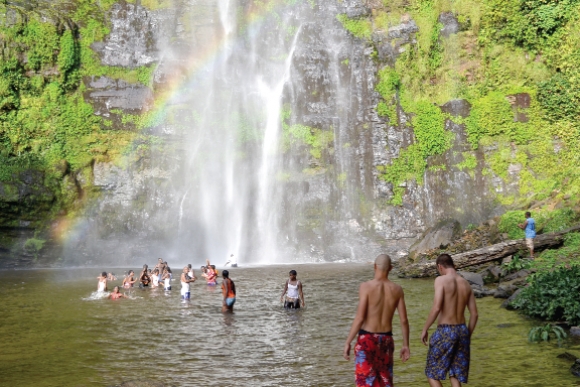Gossip
The mesmerising Wli Waterfalls
As we continue with our guest writers programme we revisit the ever refreshing Wli Fall. Seen from the perspective of Kwame Debrah and Godwin Yirenkyi, we are transported to another paradise of nature locked up in our own Ghana.
Wli, Ghana’s highest waterfall, is great in many ways and has a bright future ahead. First to be admired is the sheer grandeur of the fall itself; the spectacular white water of the Agumatsa River thundering about 60 metres down steep cliffs into a large pool below.
Second are the massive mountain formations comprising soaring peaks and rock walls which are part of the Akwapim-Togo Mountains.
Another attraction about Wli is the luxurious forest environment currently designated as the Agumatsa Wildlife Sanctuary.
Accessibility is another advantage for Wli; visitors don’t have to climb any hills or descend steep valleys to get to the foot of this awesome geological monument.
Fortunately, community support that is essential for ecotourism development of the attraction is intact. In fact, long before Wli got the attention of the tourism world, the people had always revered the mighty waterfalls and had protected it through various traditional sanctions and celebrations which are highlighted in the Agumatsa festival held in November every year.
During the festival, the people thank God for the falls, ancestral heroes are remembered and the guardian spirits of the river and the mountains are invoked to continue blessing the land and its produce.
For visitors from Accra, the 220-kilometer journey to Wli is exciting experience. From the capital, the road goes through the Tema motorway, passing the expanding industrial twin city, then along the Shai Hills wildlife resources which incorporate other huge rocky highlands, or inselbergs, such as the remarkable Twin-Rocks all lined up on the right side while the Akwapim Mountain rises in the far horizon to the northwest.
Soon after, the Volta River starts appearing near Kpong, followed by the road to the stopover town of Atimpoku where the beautiful arch of the suspended Adomi Bridge crosses the mighty Volta River, a short distance below the gigantic Akosombo dam.
Continuing, the road now goes through numerous quiet towns such as Juapong, Peki, Have and Fume, the junction to scenic Amedzofe. Logbe-Alakpleti is another junction town leading to Tafi-Atome Monkey Sanctuary just three kilometers to the west and Logba Tota with its mysterious caves located high atop the rolling mountains dominating the Eastern skyline. Agbome, Godome and Golokuati in the Ve traditional area are some of the last towns to pass before reaching Hohoe, the busy district capital.
After driving miles and miles for three hours through mainly small and quiet townships, Hohoe stands out distinctly as commercial and administrative city with its bustling market, government departments, business and service centres, hotels and banks including the Bank of Ghana and others laid along the main streets.
From here, tourists can continue by taxi or bus for the last 20 kilometers to Afegame, nestled under the towering heights of the Asoglo-Agumatsa Ranges with the upper parts of the falls glistering in the sunlight high up in the mountains.
Afegame – that means big house in the Ewe language – is situated in a strategic pass between the rugged mountains and sits exactly on the Ghana-Togo border post only 600 metres away.
The path leading to the splendid falls begins from the visitor reception centre at Afegame shaded by tall forest trees, some of them identified by their scientific and common names by the wildlife authorities. These include the Wawa, black berry, cashew, prekese, monkey cola, palm trees and climbing vines, while the forest floor is covered with ferns and shade-loving species.
Beside the majestic heights of the mountain chain are the different patterns of plant life: parts covered by dense green vegetation indicating the windward or rainy face and the leeward side carpeted by low grass and a few stunted trees.
Some of the distant peaks look blue from different angles while at close range, the steep cliffs appeared bare and where large numbers of fruit bats roosted.
In addition to the well-known bats, the forest teems with assorted animal life; the most conspicuous being the colourful insects such as butterflies and dragonflies as well as birds like pied hornbills, bulbuls, sunbirds, turtledoves and francolins, which can be seen in the tree canopies or heard calling in the bushes as one strolls to and from the falls by the meandering path which crosses the Agumatsa nine times by sturdy wooden bridges.
The falls proper consist of two parts: an upper section, which cannot be seen from the bottom, and the main falls, which drops so vertically that the plunging water actually disintegrates into a white spray before collecting once more in the plunge pool below.
Meanwhile, strong winds created by the turbulence within the gorge spray the water on the evergreen plants hanging on the cliff sides and visitors alike who appear to be soothed by the cold showers. The pool below the falling water measures about 500 square metres wide, the favourite of swimmers.
As the leading waterfall in the country, the ongoing efforts to develop the site for ecotourism will serve as an important model for the many in the area such as the Tagbo and Flabo falls as well as those in other parts of the country though the peculiar terrain and setting of each fall would demand different approaches.
The current winding path, which blends well with the forest, should be maintained for the sense of adventure it offers visitors especially during rainy seasons when the ground is quiet slippery. As a suggestion, it is important that the traditional rites associated with the protection of the Agumatsa River, such as the observance of its holy day of rest, as pertains to most rivers, should be declared and enforced to supplement conservation activities.
There are accommodation facilities at Afegame for overnight visitors. Many categories of accommodation also abound in Hohoe town; about 25 minutes’ drive from Afegame. For stress release, cultural lessons and socialisation, l recommend Wli waterfalls as your next holiday destination.
It was my first time and l was with some friends so we went swimming for about 10 minutes in the pool. To my surprise, l felt so empty when l withdrew from the pool.
The sense of emptiness was deep that l thought something was happening to me. It was a medical officer who later told me that it was stress that had left me. The relief was very amazing and l felt so refreshed.
– graphic.com.gh
















